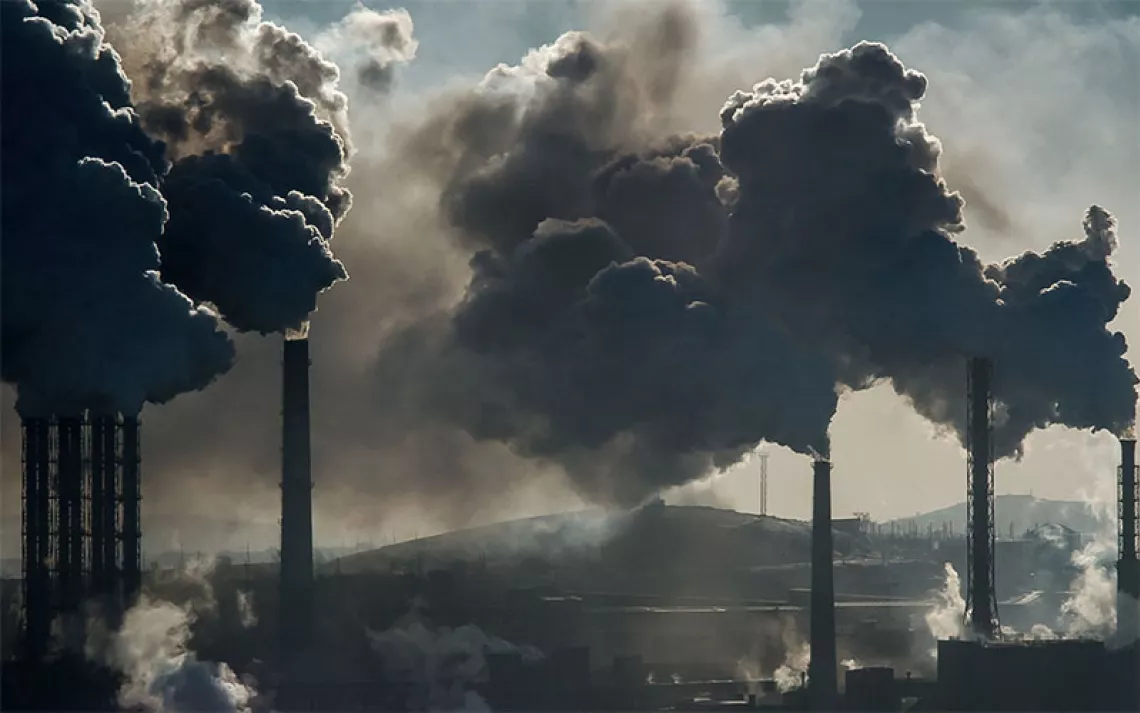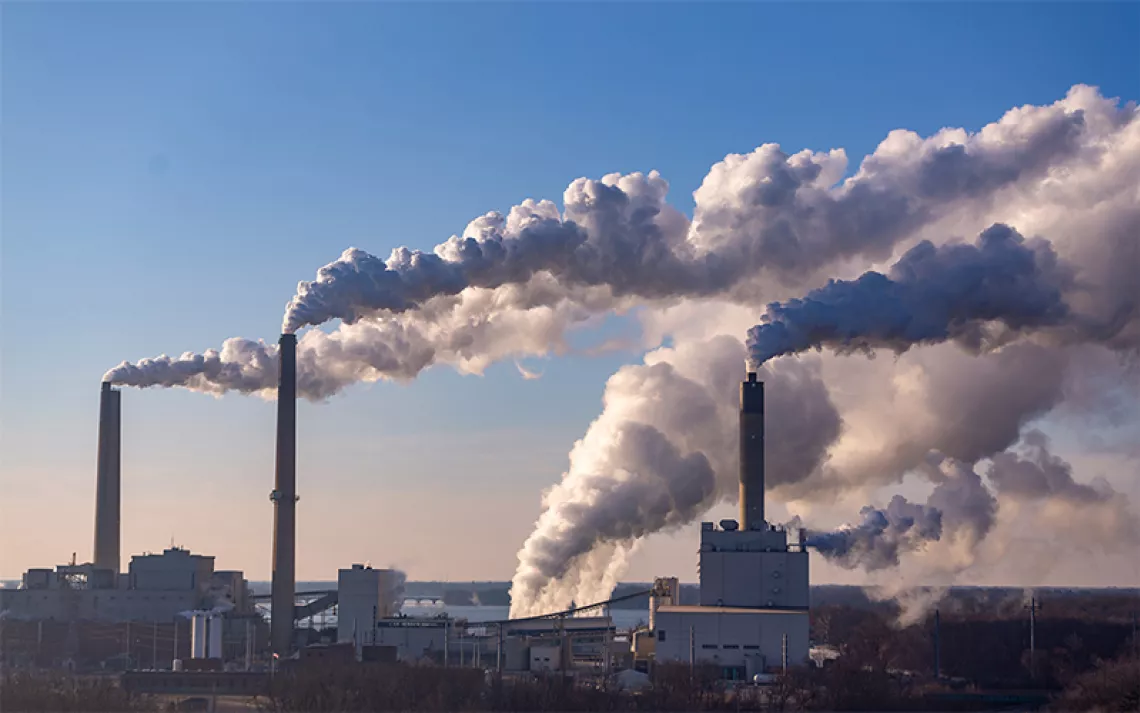Clearing Skies
A journalist who fled China's air pollution looks back and sees rays of hope.
After dark is when the pollution arrives on the outskirts of Shanghai. On a bright night, when moonlight refracts through the smog, you can see black clouds of soot pouring out of small workshop smokestacks silhouetted against the sky. In case you miss it in the dark, there's always the morning's first deep breath and the feeling of something raw in your throat.
I lived and breathed in Shanghai for 12 years, from 2002 to 2014, and those mornings seemed to grow worse. During my last three years, the first thing I'd do after waking--even before checking the weather--was to open the air-quality app on my phone. If the air was rated anything worse than "unhealthy"--the equivalent of "hazardous" under U.S. EPA guidelines, which happened at least monthly in the winter--I'd work from home. Eventually, my wife and I decided that it was time to leave the country--if not for our health, then for that of our first child.
The source of all that pollution isn't hard to track down. It's fossil fuels, and coal in particular. The numbers are astonishing, and speak to both the growth in China's economy and the penalty it pays for not taking a cleaner route to development. In 2002, for example, China consumed 1.6 billion tons of coal; in 2012 it consumed 4.15 billion tons. Much of that was high-sulfur "dirty" coal burned in factories and power plants where emissions standards were widely ignored. (See below, "Coal Turnabout.") But coal isn't the sole culprit. Between 2000 and 2013, annual new-vehicle sales in China grew by more than 900 percent, to 22 million (Americans bought 15.6 million cars in 2013). In part to fuel those vehicles, China went from burning 4.8 million barrels of oil per day to 10.1 million barrels per day.
Other, less obvious sources of pollution can be even more damaging. For example, unlike the United States and the European Union, China allows oil tankers and container vessels to burn high-sulfur oil in its ports. Just one such ship cruising the Chinese coast can emit as much pollution in a day as 500,000 trucks. Shipping emissions lead to at least 1,600 deaths per year in China's Pearl River Delta (which includes Guangzhou, Shenzhen, and Hong Kong), according to a 2014 Natural Resources Defense Council study. Altogether, in 2010 air pollution contributed to 1.2 million premature deaths in China, according to data from the 2010 Global Burden of Disease Study. In all likelihood, that number has only increased in recent years.
In spite of this, I am more optimistic than ever about China's commitment to tackling its pollution. In the past five years, in particular, Chinese citizens, newly empowered by social media (China has more people connected to the Internet than any other country), have become loud and powerful critics of China's debilitating air quality, and the government is taking notice.
"It's causing an uproar, and it's a threat to the leadership and the government--which they take very seriously," explained Knut Alfsen, a Norwegian climate scientist and an adviser to the China Council for International Cooperation on Environment and Development, a high-level advisory body to the Chinese government.
The government is starting to take actions small and large. In November, China handed the residents of Beijing a six-day vacation, enacted traffic restrictions, shut down factories, and even closed crematoriums. All so 21 heads of state, including President Barack Obama, attending the Asia Pacific Economic Cooperation (APEC) meeting there, and the international media accompanying them, wouldn't arrive in a smog-choked city.
The resulting blue skies--quickly dubbed "APEC blue" by locals--were temporary. But the stunt, according to Ma Jun, perhaps China's most influential environmental advocate and the founder of the Beijing-based Institute of Public and Environmental Affairs, had value. "APEC blue demonstrated to people that we don't need to take 30 or 50 years to get our sky back," he said. "This public recognition, emphasized by [Chinese] President Xi [Jinping], is helpful for us."
How helpful? At the end of the APEC meeting, Presidents Obama and Xi agreed to a landmark deal on reducing greenhouse gas emissions. The details are impressive, including a Chinese promise to cap its total greenhouse gas emissions no later than the year 2030 and to make renewable power 20 percent of its overall energy mix by then. They're also extremely ambitious. "They need to increase renewables by 6 to 8 percent per year to get there by 2030," Alfsen says. That won't be easy, but Alfsen has good reason to believe it'll happen. "When they set targets," he said, referring to Chinese officials, "they usually deliver."
Despite the significant and long-term challenges to cleaning up China's air and greenhouse gas emissions, four important developments suggest that--just maybe--China's challenges can be met over the long-term.
I. Economic Developments
For environmentalists outside China, the country's air pollution problem is an ongoing good-versus-evil emergency. But viewed from within, it's a bit more morally ambiguous. That's not to defend China's pollution but rather to highlight the rapid changes in living standards and life expectancy that three-plus decades of unregulated, fast-growth development have brought to hundreds of millions of China's 1.3 billion citizens.
When people ask me what changed most during my years in Shanghai, I always answer that each freshman class of kids at the high school up the street from my apartment of eight years was noticeably taller than the last. "Everybody is richer now," one of my friends, a teacher at a different high school, told me. "They can buy better food." That wealth comes from a lot of places, but one of the sources is undoubtedly a fast-growing economy fueled by cheap carbon.
The health benefits run deeper yet. Consider that between the start of Communist Party rule in China in 1949 and today, the average life span more than doubled to 75 years. A country with no middle class to speak of only three decades earlier suddenly had the world's largest.
As long as living standards and life expectancy kept moving up--and they did, for decades--air pollution assumed a lower priority than it would have in a developed country. Of course, at some point, economies slow, people have enough to eat, and there are only so many mobile phones you can buy. China reached that point in the mid-2000s. The comeuppance, especially for the government, was powerful. "No country becomes so rich that its citizens do not need to breathe," says Nathaniel Bullard, an analyst at Bloomberg New Energy Finance who covers clean energy and energy technology from Hong Kong. "The data on health impacts are clear, and just as clear to the government are the social implications of this reduced health, welfare, and happiness."
II. An Avalanche of Data
It was also in the mid-2000s that the Institute of Public and Environmental Affairs began to post publicly available--but never before collected or collated--data on water pollution to the Web. Suddenly citizens who'd been willing to ignore pollution were waking up to clear evidence of diminishing returns from fast economic growth. In 2013, only 3 of the 74 cities that China monitors for air quality met the country's very modest standards. China's mass drive to urbanize, once a source of wealth and better health, now increasingly looked like a pollution-addled trap.
Still, it has taken time for the government to get the message. As recently as 2011, Chinese state media regularly referred to the thick white haze that hung over China's cities as "fog" rather than "smog." But several years earlier, the U.S. embassy in Beijing had begun releasing hourly data on China's air pollution via Twitter. The feed and eventually Twitter itself were blocked, but savvy Internet users just went about reposting the information to Chinese social media sites. Now many Chinese know what they're breathing and, predictably, they're not happy. "We are seeing pressure to drive the serial polluters to change," says the Institute of Public and Environmental Affairs' Ma.
The avalanche of data is beginning to affect policy. In January 2013, Beijing experienced what came to be known as an "airpocalypse"--a smog incident (and not the first) in which pollution levels were off the EPA's air-quality scale. The events, which can last for days, are disturbing, dangerous, and galvanizing. Chinese social media users began demanding action from the government, and the government--an authoritarian institution whose legitimacy is drawn largely from its promise to improve living standards--fast-tracked the installation of air-quality monitors across the country. More significantly, it responded in September 2013 with a comprehensive action plan to tackle China's air pollution that will eliminate coal-fired boilers and upgrade the quality of fuel oil, among other measures. It also requires coal to be reduced to 65 percent of China's energy mix by 2017.
The increasing volume of data on the sources of Chinese pollution is also making it easier for the committed central government in Beijing to pick its internal fights, and win them.
For example, real-time pollution data from power plants in highly polluted Hebei and Shandong Provinces, collected by the Institute of Public and Environmental Affairs, show that the 21 largest polluters account for 90 percent of nitrogen oxide emissions. Those emissions could be halved if those plants were held to the new air-quality standards that President Xi announced in 2013. Will such measures solve China's air pollution woes? "That's not something that's fixed in a five-year plan," climate scientist Alfsen said, referring to the social and economic development programs that have guided China since 1953 and are now in their 12th iteration. But the popular sentiment inspiring them is moving China in the right direction. "I'm impressed by the willingness and the priorities of the government, but also the priorities and willingness of the Chinese public," Alfsen said.
III. Elites Are Fed Up Too
In the late fall of 2011, right about the time that Chinese social media was about to revolt over air pollution, the Broad Air Conditioning Company in Changsha, Hunan Province, made a marketing error. In hopes of juicing up sales for its high-end air purifiers, the company decided to reveal one of its most exacting customers: the Chinese government. In an advertisement, Broad announced that it had placed more than 200 such pollution-fighting filters in the very centers of Chinese power, including the Great Hall of the People, the Zhongnanhai leadership compound, and even the office of then-president Hu Jintao.
Needless to say, the ad didn't go over well with China's government or its furious social media users, and it was pulled. But the air purifiers? Presumably they're still scrubbing away, making Beijing's air safe for its leaders.
Privileged Chinese have the means to protect themselves from pollution, and for many, the solution is simple: flee. "North China's air quality is driving away wealthy citizens and making it hard to attract and retain global executives," Bloomberg's Bullard said. According to one study, 64 percent of Chinese millionaires have already emigrated or are planning to. Among the most cited reasons: pollution, food safety, and educational opportunities.
It's an economic and a public relations disaster, and it's not just the rich and powerful who are leaving. In 2014, 274,000 Chinese citizens were studying in U.S. universities, and less than half of them will return to China. Job opportunities and other socioeconomic factors play a role. But so does pollution and its effect on children.
It's not clear whether reducing pollution will bring them back, but China's air filter-possessing leaders know personally why large numbers of the country's increasingly wealthy citizens want to leave, so they're willing to give antipollution measures a try.
IV. Headway on Conservation
The horror-show photos of China's winter smog that can be seen on websites and in newspapers remind people of the toll that fossil fuels are taking on China. But if there's a downside to such photos, it's that they tend to put the focus on the energy-generation side of China's pollution problem rather than on the consumption side. Ultimately, pollution is caused by energy use, whether by factories making iPhones, buses transporting students to school, or homes being heated during the north China winter.
For the Chinese government, now committed to huge reductions in energy-related emissions, efficiency measures are enticing, low-hanging fruit--much easier to implement than, say, converting coal-burning power plants to renewables. "A lot of the progress in energy efficiency can be achieved via low-cost, no-cost measures," said BarbaraFinamore, Asia director for the Natural Resources Defense Council. "There's a tremendous amount of energy wasted through poor management, lack of training, things like that. And that's where the biggest bang for the buck is."
Up to 26 percent of energy use in China is related to powering buildings. That's less than the global average of 40 percent, but China's number is set to grow: The country's building floor space and energy consumption are both projected to double by 2050. That, in itself, is reason to question whether China can meet its new greenhouse gas commitments. But it's even more frightening when you take into account that only 5 percent of China's buildings currently meet the country's meager building energy-conservation standards. Fortunately, the government began spending money on energy-efficient-home retrofit projects back in the 1990s, converting millions of square feet of leaky, poorly insulated homes into green ones. Meanwhile, factories that depended on coal burning for energy are being moved to other, cleaner-burning power sources. "Energy efficiency is the cheapest, cleanest, and fastest energy resource there is," Finamore said. "And they're really using it."
These trends, however shaky, suggest that China is beginning to turn in the right direction. Bloomberg's Bullard believes that China is inherently capable of maintaining its momentum. "Only a country with China's level of coordination and commitment could build so much fossil fuel-generation capacity so quickly," he said. "And now the economic development that extraordinary power output created gives China the wealth, wherewithal, and willpower to change its path."
This story has been corrected from the print version.
Coal Turnabout

Carrington Coal Terminal, Newcastle, New South Wales, Australia | Photo by David Wall Photo.
At the stroke of midnight, New Year's Eve 2015, residents of some of China's biggest cities started breathing just a little easier, thanks to a new ban on the burning of high-sulfur, high-ash-content coal in major population centers. China also imposed restrictions on the import and mining of such "dirty" coal. It's a definite, throat-clearing step in the right direction.
Unless you're an Australian coal boss, that is.
Coal is Australia's second-most-valuable export, and China has been its second-biggest coal customer for years, importing around 49 million tons annually. That status may not last much longer, however--much to the discomfort of some Australians. The dirty-coal restriction alone threatens to impact roughly 40 percent of that trade, by some estimates.
And the pace of change will likely accelerate. Over the past few years, China has been making massive investments in renewables. In the first half of 2014, for example, China added enough hydropower to its grid to replace 26 million tons of coal per year. Of course, China has many other sources of coal--including its own mines. But the move away from coal is undeniable and historic. Indeed, according to a landmark October 2014 energy analysis by Greenpeace, coal use in China dropped by roughly
1 percent in the second and third quarters of 2014--a first for China in the 21st century. And in November 2014, the Chinese government announced that it would cap its coal use by 2020. Meanwhile, defying decades of doomsayers who insisted that China and coal grow together,
China's economy expanded more than 7 percent in 2014. The impact on China's skies is yet to be seen. But in Australia, it's already being felt. In November, international mining goliath Glencore announced three-week production shutdowns at its Australian mines as a result of "over supply."
The geopolitical and economic factors that influence the global coal trade make it hard to predict, but there's plenty of reason to believe that the world's biggest coal consumer can wean itself from its biggest pusher. "Let me remind you: China is also the world's biggest manufacturer of solar panels, its biggest installer of wind turbines and solar panels, and it has very deep financial markets to fund expansion and installation," Bloomberg New Energy Finance analyst Nathaniel Bullard said in an email from Hong Kong. "The toolbox for changing China's carbon footprint is in place; it just needs to be opened further."--A.M.
 The Magazine of The Sierra Club
The Magazine of The Sierra Club








